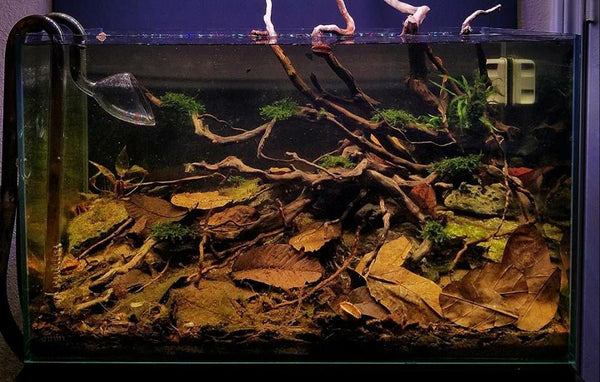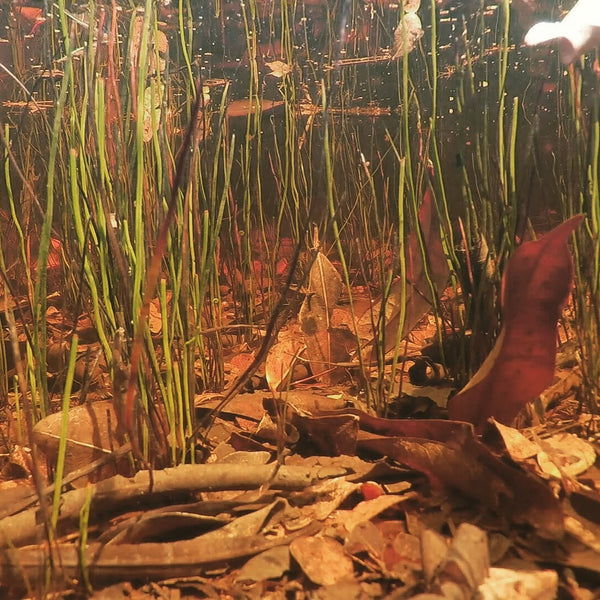- Continue Shopping
- Your Cart is Empty
The departure....and reaching common ground.
If you read my meanderings every day, you know I tend to go on and on about how I feel that truly "natural style" aquariums are both aesthetically equivalent and functionally superior to those strictly set up with just an "artistic look" in mind.
Sure, you can marry the two somewhat. However, the one thing that I think we need to constantly remind ourselves of is that, typically, nature looks nothing like our interpretation. It's simply not neat, ordered by color, height, and texture.
Aquatics plants grow based on the availability of nutrients, light, and a suitable substrate. We all know this. We all know that they tend to aggregate in certain areas because those areas meet their needs. It's a no brainer.
Yet, like terrestrial gardeners since time immemorial, we place them carefully into our aquariums in specific, measured aggregations, often arranged by color or texture. Right next to our geometrically perfect, ratio-correct wood and rocks.
Pulling away from the popular, well-trodden path is always a "departure" of sorts that takes many of us out of our comfort zone. It can be a bit scary. It can open you up to criticism; to the inevitable "hushed whispers" from fellow aquascapers.
Why is this a problem?
Now, don't get me wrong. There is no hate here. I'm a huge fan of aquascapers who do artistically-fabulous aquaecapes. This is not a critique. Just a question. I question, because I spend a good portion of my free time (which isn't that much these days, lol) looking at aquascapes and aquariums on my social media feeds, and I can't help but reflect on this as I study the work of some very talented hobbyists. There is an incredible body of work out there.

It just seems to me that there is a an opportunity to embrace the beauty in randomness, and yet many seem to eschew this randomness for the comfort that is provided by some sort of design and order. There seems to be no reason for this. You have a shitload of talent! For talented hobbyists to avoid trying something different like this, it's like keeping the "training wheels" on your child's bike when we know she can competently and safely ride without them.
Take the training wheels off!
Just look at Nature in the same manner- and with the same reverence- that many 'scapers do when they laud last month's big "fantasy scape" that's all over social media. There is so much inspiration there.
Consider the way aquatic plants grow in nature, for example.

In this image by our friend, Tomas Minesi of Republic of Congo, we can see the Ludwigia growing (in very shallow water, mind you!) in a sort of a monospecific aggregation, while spreading out along the margins of this stream.
in a wider shot, you can see that the plants grow into conditions which favor their growth and continued existence. Nature pays no mind to our artistic interpretations, "Golden Ratios", arrangements, trends, etc.
And it's still compelling and alluring.

As we've established and evolved our vision of the blackwater/botanical-style aquarium, it's really fun to see the incredible diversity of approaches that everyone takes towards creating something cool. I mean, one would think that to use botanicals, you just "prep 'em and plop 'em" in the tank, and that's it!. Well, as we both know, there's a lot more to it than that!
I suppose that we can look at the use of botanicals in our aquariums from two approaches, really:
*Purely aesthetic
*Purely functional
That sounds right; however, I think that the two actually go hand in hand.
Huh?
In the case of botanicals, you can't ever lose sight of the fact that you're literally adding a piece of natural material into your closed ecosystem. These materials WILL impact water chemistry, biological activity...oh, and the "structure" of your aquascape.
We don't fight that.

Over the years, I have coined (well, I like to arrogantly THINK that I coined it-perhaps I simply appropriated it from somewhere...) the term "functional aesthetics" to describe this dichotomy. That is: This stuff gives your tank a certain look (in terms of the visual appearance of the "hardscape" and the color it imparts to the water), while impacting some of the environmental parameters simultaneously.

And this idea is not really "new", in terms of tangible affects of adding "stuff" to our tanks. I mean, every time we add a piece of wood to our aquarium, there is some leaching of tannins and other compounds into the water. Lover's of "crystal-clear, blue-white water" may do everything in their power to neutralize the impact immediately via activated carbon or other chemical filtration media, but the fact is, there is an impact caused by using these materials in our aquariums.

In our instance, we've made the conscious decision to embrace what nature offers up and "accept" the tinted water, decomposing botanical materials, and detritus, and their impact on pH (when conditions are suitable) and possibly even the nutrient load imparted by these materials. Others resit it, trying to make natural materials conform with their personal interpretation. This is where we part ways, so to speak, with many friends in the broader aquascaping universe, and chart our own course.
A departure.

However, it doesn't need to be that way.
We need to find common ground.
When I have occasion to explain our "botanical-style" approach to a hobbyist not familiar with it, especially one who is devoted to that "high concept, blue-white water look", they're with me right up until the part where I describe the impact these materials have on the color of the water. It's an aesthetic that many simply cannot get past.
And I get that. And the idea of a "jumble" of decomposing seed pods, bark, and leaves, often covered in biofilm, is simply not everyone's idea of a good-looking aquarium.

You can show some aquarists hours of underwater footage of Amazonian igapo flooded forests, Asian peat bogs, and African rain forest streams, which our tanks tend to resemble, and they still won't be able to get over the "fantasy diorama aesthetic" that's been perpetuated as the most "natural-looking" aquarium for a couple of decades now.
Again, I can't fault them at all.
Many of those tanks that are the darlings of the aquascape world are artistic masterpieces. However, they bare as much resemblance to a wild habitat as a potted plant does to a rain forest, IMHO. I don't hate on the wonderful work or aesthetics of these tanks at all.
I just strongly disagree with the public perception (and the attitude I've received from some corners) that these 'scapes are the ultimate statement of "natural aquascaping." And some of the downright nasty accusations I've received from some people from this "world" over the past few years calling what we do "reckless", "undisciplined", and "aesthetically lacking" makes me realize we're doing exactly the right thing here! 😆

There are many possible "ultimate statements" in aquascaping. Look at many of the wonderful, painstakingly-researched and brilliantly-executed aquariums from hardcore biotope aquarium fans. Again, perhaps not everyone's cup of tea, yet true biotope aquariums are some of the most incredible, natural-looking aquariums you're ever likely to encounter. Even if they're more about what nature looks like than they are about conforming to Japanese garden principles or European design standards or whatever.

That's a point where we can all perhaps find some common ground.
To me, the idea of "functional aesthetics" is every bit as appealing as any purely artistic scape concept out there. And when you see the work by aquascaping masters like Johnny Ciotti, Mitch Mazur, Cory Hopkins, or Jeff Senske- aquascapers which can hold their own with anyone on the planet- fusing art and Nature togetether, you'd have a hard time disagreeing and thinking that the two must be mutually exclusive. Each one of these guys has embraced the use of botanicals in their own way, forging their own interpretation of "functional aesthetics."
Mixing art and design with function, it's pretty cool!
What is increasingly exciting and interesting to me is to see more and more of you playing with planted blackwater aquariums. Not only are you simply "going for it", and trying regardless of "what they say"- you're learning exactly what the impacts of blackwater environments are on the growth of some of our favorite aquatic plants. Really good stuff. And work that is serving to bridge the gap between two worlds of aquascaping!

We're seeing more and more of this type of "crossover" aquascaping work, and I think it's doing more than just "making a statement" or inspiring others. It's helping open up minds, opinions, and-perhaps most important of all- call some attention to the unique wild habitats of our aquarium fishes- some of which face grave threats from humankind's interventions. This is perhaps the ultimate benefit of embracing the idea of more naturally-functioning and appearing aquariums- biotope and otherwise.
Getting some inspiration from the environment when designing our tanks is something that we've done for a century, yet in recent years, we've eschewed it for a more "stylized interpretation"- which seems to make the idea of looking at nature and replicating it more directly "fresh", and oddly compelling once again!
A departure? Perhaps, right?
Rather than inspiring hobbyists to simply mimic other people's tanks, getting inspiration from Nature helps to call attention to the natural habitats as they are, and encourages aquarists to find out more about them; how they work, what is happening in them, etc. And if that inspires some people to set up a botanical-style aquarium-despite their initial "aversion" to the "unconventional" aesthetic- it's a victory not only for the hobby- but for Nature as well.

If we are honest with ourselves, and aren't afraid to tell things like they are, I think that hobbyists worldwide can really unite and share ideas and respect from a wide range of different approaches. We can embrace lots of ideas without being overly dogmatic.
Reaching out across the "tint gap" with a mangrove branch, Cariniana Pod, or whatever (metaphorically AND literally, lol) can go a long way towards opening up minds and helping embrace the talent, knowledge, and work ethic that exists in the aquarium world. Being open-minded to many aspects of the aquatic world builds better hobbyists, a better hobby- and calls greater and greater attention to the precious natural aquatic habitats of our planet.
Literally blurring the liens between Nature and aquarium.
Comprehending the idea of "functional aesthetics" a good start. And, in reality, it's really just the jumping off point on a journey that will forever continue. And we're all better off if we take that journey together.
Reach out to a friend who might be a bit close-minded, unfamiliar with, or otherwise put off by our style and interpretation of nature. Share with him our her the concepts, challenges, and ideas we work with. Challenge him/her to look at a video or image of a natural habitat, to understand the infinite diversity and opportunities that Nature offers, and attempt to replicate it in an "unfiltered" manner in an aquarium.

However, try to understand his/her perception of aquascaping and aesthetic, and appreciate why they might find some of the stuff we accept without reflection somewhat scary. Share our idea of "functional aesthetics" with a seemingly close-minded friend. You might just find that we're not really that far apart in our views.
Find common ground.
And grow.
THAT is actually a "departure" of sorts, isn't it?
Until next time...
Stay creative. Stay original. Stay observant. Stay collegial. Stay diligent...
And Stay Wet.
Scott Fellman
Tannin Aquatics












Scott Fellman
Author